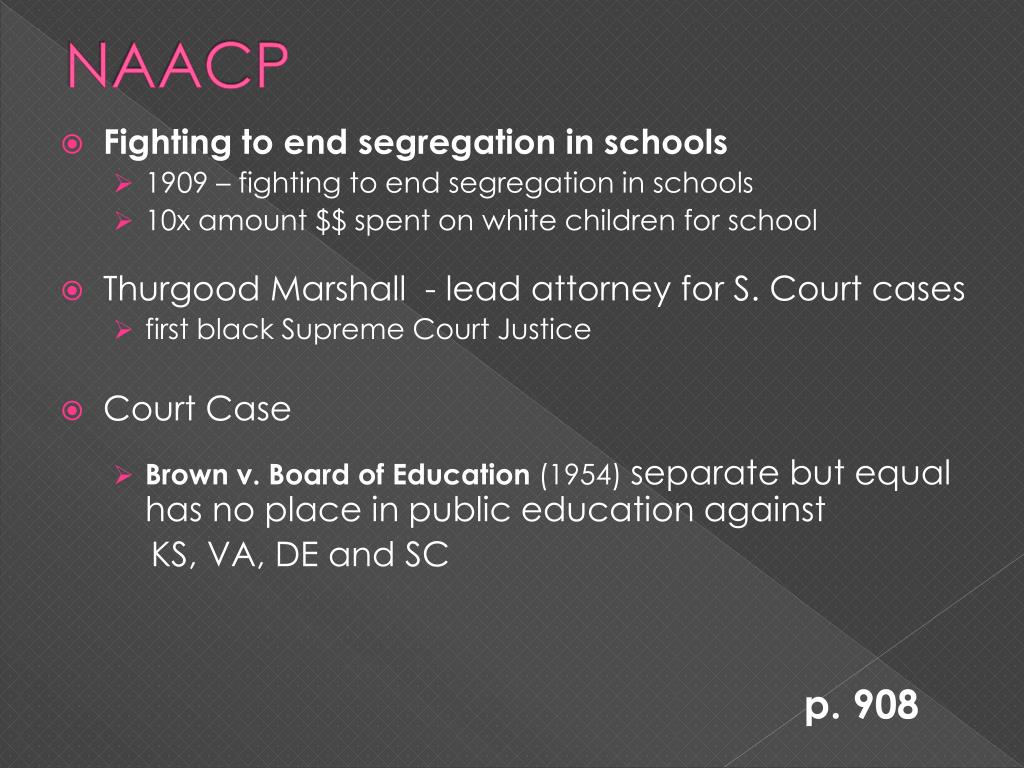NAACP attorneys Oliver Hill and Samuel Tucker lead a group of African American children and parents through the courthouse doors, followed by George R. Ferguson and others. State Attorney General Albertis S. Harrison enters the courtroom, followed by a group of other lawyers. Anchor Script
Who was the lead attorney for the NAACP in school board cases?
I was the lead NAACP attorney on a school integration case in Virginia in the 1950s. Ulysess S. Grant I became the top Union general in the Civil War and one of the Reconstruction presidents.
Who was the Attorney for the Arlington Education Association?
Born in 1908, Thurgood Marshall served as lead attorney for the plaintiffs in Briggs v. Elliott. From 1930 to 1933, Marshall attended Howard University Law School and came under the immediate influence of the school’s new dean, Charles Hamilton Houston. Marshall, who also served as lead counsel in the Brown v.
Who was involved in ending segregation in the South Carolina NAACP?
Mar 22, 2021 · Federal District Judge John Paul – who earned his law degree from UVA in 1906 – heard the case in July and issued what NAACP lawyer S.W. Tucker termed “a beautiful ruling”: that the school board start ending race assignments of pupils in September. 4 Paul’s ruling immediately evoked a strident, defiant outcry from segregationists. The Defenders held a mass …
Who was the chief counsel for the South Carolina NAACP?
The first African American admitted to the Delaware bar, Louis Redding was part of the NAACP legal team that challenged school segregation. Jack Greenberg As the first white attorney for the NAACP, Jack Greenberg helped to argue Brown v.

Louis Redding
The first African American admitted to the Delaware bar, Louis Redding was part of the NAACP legal team that challenged school segregation.
Jack Greenberg
As the first white attorney for the NAACP, Jack Greenberg helped to argue Brown v. Board of Education at the U.S. Supreme Court level.
Thurgood Marshall
Thurgood Marshall led a life in the pursuit of equality, and was on a path destined to lead him to the U.S. Supreme Court. Read More...
George E.C. Hayes
George E.C. Hayes was responsible for starting the oral argument of Bolling v. Sharpe, the case which originated in the District of Columbia
Charles Hamilton Houston
Houston developed a "Top-Down" integration strategy, and became known as "The Man Who Killed Jim Crow" for his desegregation work.
James Nabrit, Jr
Nabrit took over Charles Hamilton Houston's work on the Bolling v. Sharpe case which went to the U.S. Supreme Court alongside four others.
Harold R. Boulware
Harold Boulware served as the chief counsel for the South Carolina NAACP chapter and was instrumental in the Briggs case.
Who was Thurgood Marshall's legal assistant?
After his release from the army in 1944, Carter became a legal assistant to Thurgood Marshall, and the following year he became an assistant special counsel. Carter served as lead attorney in the Topeka school desegregation case, one of the five cases which were consolidated to form Brown.
Who was the Dean of Howard University School of Law?
Robinson became Dean of Howard University School of Law and a member of the United States Commission on Civil Rights from 1961 to 1963. In 1964, Robinson was appointed to the United States District Court for the District of Columbia and was elevated two years later by President Johnson to the D.C. Circuit Court.
What did Marshall say about segregation?
Board of Education, which he argued before the Supreme Court in 1952 and 1953, finally overturning “separate but equal” and acknowledging that segrega tion greatly diminished students’ self-esteem.
Which Supreme Court case was the death penalty violated?
He scored a major victory in Furman v. Georgia in which the Supreme Court held that the death penalty violated the “cruel and unusual punishment” clause of the Eighth Amendment.
Who was the first African American to serve on the Supreme Court?
He eventually became the first African American Justice on the Supreme Court of the United States. Jack Greenberg succeeded Thurgood Marshall as LDF’s second Director-Counsel from 1961-84. Greenberg first joined LDF in 1949 as a 24-year-old Columbia Law School graduate.
Who won Brown v Board of Education?
This became one of five cases decided under Brown. Charles Hamilton Houston played an invaluable role in dismantling segregation and mentoring the crop of civil rights lawyers who would ultimately litigate and win Brown v Board of Education.
Who was the first African American president of Howard University?
Mordecai Johnson, the first African American president of Howard University, named Houston to lead the law school in 1929. Houston was involved in nearly every civil rights case before the Supreme Court between 1930 and 1954. He is credited with designing the strategy that ultimately ended Jim Crow.
What was the NAACP lawsuit?
On June 1, 1956, Alabama attorney general John M. Patterson sued the NAACP for violation of a state law requiring out-of-state corporations to register. A state judge ordered the NAACP to suspend operations and submit branch records, including membership lists, or incur a $100,000 fine. In NAACP v.
What was the NAACP's response to the Brown v. Board of Education decision?
Board of Education decision, which overturned the “separate but equal” doctrine . Former NAACP Branch Secretary Rosa Parks’ refusal to yield her seat to a white man sparked the Montgomery Bus Boycott and the modern civil rights movement. In response to the Brown decision, Southern states launched a variety of tactics to evade school desegregation, while the NAACP countered aggressively in the courts for enforcement. The resistance to Brown peaked in 1957–58 during the crisis at Little Rock Arkansas’s Central High School. The Ku Klux Klan and other white supremacist groups targeted NAACP officials for assassination and tried to ban the NAACP from operating in the South. However, NAACP membership grew, particularly in the South. NAACP Youth Council chapters staged sit-in demonstrations at lunch counters to protest segregation. The NAACP was instrumental in organizing the 1963 March on Washington, the largest mass protest for civil rights. The following year, the NAACP joined the Council of Federated Organizations to launch Mississippi Freedom Summer, a massive project that assembled hundreds of volunteers to participate in voter registration and education. The NAACP-led Leadership Conference on Civil Rights, a coalition of civil rights organizations, spearheaded the drive to win passage of the major civil rights legislation of the era: the Civil Rights Act of 1957; the Civil Rights Act of 1964; the Voting Rights Act of 1965; and the Fair Housing Act of 1968.
What was the goal of the NAACP in 1953?
In 1953 the NAACP initiated the “Fight for Freedom” campaign with the goal of abolishing segregation and discrimination by 1963, the centennial of Abraham Lincoln’s Emancipation Proclamation. The NAACP vowed to raise one million dollars annually through1963 to fund the campaign.
Why was Rosa Parks arrested?
On December 1, 1955, Rosa Parks, age forty-three, was arrested for disorderly conduct in Montgomery, Alabama, for refusing to give up her bus seat to a white passenger. Her arrest and fourteen dollar fine for violating a city ordinance led African American bus riders and others to boycott the Montgomery city buses. It also helped to establish the Montgomery Improvement Association led by a then-unknown young minister from Dexter Avenue Baptist Church, Martin Luther King, Jr. The boycott lasted for one year and brought the Civil Rights Movement and Dr. King worldwide attention.
How did James Meredith get into the University of Mississippi?
In September 1962, a federal court ordered the University of Mississippi to accept James Meredith, a twenty-eight-year-old Air Force Veteran , after a sixteen-month legal battle. Mississippi Governor Ross Barnett disobeyed the decree and had Meredith physically barred from enrolling. President Kennedy responded by federalizing the National Guard and sending Army troops to protect Meredith. After days of violence and rioting by whites, Meredith, escorted by federal marshals, enrolled on October 1, 1962. Two men were killed in the turmoil and more than 300 injured. Because he had earned credits in the military and at Jackson State College, Meredith graduated the following August without incident.
Who was Clarence Mitchell?
Baltimore native Clarence Mitchell (1911–1984) attended Lincoln University and the University of Maryland Law School. He began his career as a reporter. During World War II he served on the War Manpower Commission and the Fair Employment Practices Committee. In 1946 Mitchell joined the NAACP as its first labor secretary. He served concurrently as director of the NAACP Washington Bureau, the NAACP’s chief lobbyist, and legislative chairman of the Leadership Conference on Civil Rights from 1950 to 1978. Mitchell waged a tireless campaign on Capitol Hill to secure the passage of a comprehensive series of civil rights laws: the 1957 Civil Rights Act, the 1960 Civil Rights Act, the 1964 Civil Rights Act, the 1965 Voting Rights Act, and the 1968 Fair Housing Act. His invincible determination won him the accolade of “101st U.S. Senator.”
What was the response to the Brown decision?
In response to the Brown decision, Southern states launched a variety of tactics to evade school desegregation, while the NAACP countered aggressively in the courts for enforcement. The resistance to Brown peaked in 1957–58 during the crisis at Little Rock Arkansas’s Central High School.

Popular Posts:
- 1. can i release medical records to a family member who has power of attorney
- 2. who should pay my medical bills medicaid or attorney
- 3. what is the standard attorney fee
- 4. what court case was the right to an attorney
- 5. what happens if a person misses showing up to an attorney office for a deposition
- 6. where can i find a irs tax attorney in pensacola florida
- 7. who gets copies of durable power of attorney
- 8. how can a us attorney practice in uk
- 9. how to write to the attorney general
- 10. who was ted bundy defense attorney